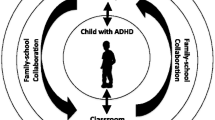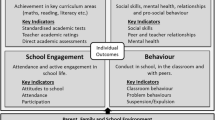Abstract
School engagement protects against negative mental health outcomes; however, few studies examined the relationship between school engagement and attention-deficit hyperactivity disorder (ADHD) using an ecological framework. The aims were to examine: (1) whether school engagement has an independent protective association against the risk of ADHD in children, and (2) whether environmental factors have an association with ADHD either directly or indirectly via their association with school engagement. This cross-sectional study used data from the 2011–2012 National Survey of Children’s Health, which collected information about children’s mental health, family life, school, and community. The sample contained 65,680 children aged 6–17 years. Structural equation modeling was used to estimate the direct association of school engagement and ADHD and indirect associations of latent environmental variables (e.g., family socioeconomic status (SES), adverse childhood experiences (ACEs), environmental safety, and neighborhood amenities) and ADHD. School engagement had a direct and inverse relationship with ADHD (β = − 0.35, p < 0.001) such that an increase in school engagement corresponds with a decrease in ADHD diagnosis. In addition, family SES (β = − 0.03, p = 0.002), ACEs (β = 0.10, p < 0.001), environment safety (β = − 0.10, p < 0.001), and neighborhood amenities (β = − 0.01, p = 0.025) all had an indirect association with ADHD via school engagement. In conclusion, school engagement had a direct association with ADHD. Furthermore, environmental correlates showed indirect associations with ADHD via school engagement. School programs targeted at reducing ADHD should consider family and community factors in their interventions.



Similar content being viewed by others
References
American Psychiatric Association (2013) Diagnostic and statistical manual of mental disorders (DSM-5), 5th edn. American Psychiatric Publishing, Washington
Boyle CA et al (2011) Trends in the prevalence of developmental disabilities in US children, 1997–2008. Pediatrics 127(6):1034–1042
Barbaresi WJ et al (2007) Long-term school outcomes for children with attention-deficit/hyperactivity disorder: a population-based perspective. J Dev Behav Pediatr 28(4):265–273
Biederman J et al (1996) Predictors of persistence and remission of ADHD into adolescence: results from a four-year prospective follow-up study. J Am Acad Child Adolesc Psychiatry 35(3):343–351
Pastor PN, Reuben CA (2006) Identified attention-deficit/hyperactivity disorder and medically attended, nonfatal injuries: US school-age children, 1997–2002. Ambul Pediatr 6(1):38–44
Curry AE et al (2017) Motor vehicle crash risk among adolescents and young adults with attention-deficit/hyperactivity disorder. JAMA Pediatr 171(8):756–763
Frazier TW, Demaree HA, Youngstrom EA (2004) Meta-analysis of intellectual and neuropsychological test performance in attention-deficit/hyperactivity disorder. Neuropsychology 18(3):543–555
Faraone SV et al (2005) Molecular genetics of attention-deficit/hyperactivity disorder. Biol Psychiatry 57(11):1313–1323
Fielding JE, Teutsch S, Breslow L (2010) A framework for public health in the United States. Public Health Rev 32(1):174–189
Hofferth SL, Sandberg JF (2001) How American children spend their time. J Marriage Fam 63(2):295–308
Appleton JJ, Christenson SL, Furlong MJ (2008) Student engagement with school: critical conceptual and methodological issues of the construct. Psychol Sch 45(5):369–386
Resnick MD et al (1997) Protecting adolescent’s from harm: findings from the national longitudinal study on adolescent health. J Am Med Assoc 278(10):823–832
Millings A et al (2012) School connectedness, peer attachment, and self-esteem as predictors of adolescent depression. J Adolesc 35(4):1061–1067
Rutter M (1987) Psychosocial resilience and protective mechanisms. Am J Orthopsychiatry 57(3):316–331
Sameroff AJ (2000) Ecological perspectives on developmental risk. WAIMH Handb Infant Ment Health 4:1–33
Snyder SM, Smith RE (2015) The influence of school engagement on counts of delinquent behaviors among maltreated youths. Child Sch 37(4):199–206
Oldfield J, Humphrey N, Hebron J (2016) The role of parental and peer attachment relationships and school connectedness in predicting adolescent mental health outcomes. Child Adolesc Ment Health 21(1):21–29
Zendarski N et al (2017) Early high school engagement in students with attention/deficit hyperactivity disorder. Br J Educ Psychol 87(2):127–145
Shochet IM et al (2006) School connectedness is an underemphasized parameter in adolescent mental health: results of a community prediction study. J Clin Child Adolesc Psychol 35(2):170–179
Kuperminc GP, Leadbeater BJ, Blatt SJ (2001) School social climate and individual differences in vulnerability to psychopathology among middle school students. J Sch Psychol 39(2):141–159
Bowen NK, Bowen GL (1999) Effects of crime and violence in neighborhoods and schools on the school behavior and performance of adolescents. J Adolesc Res 14(3):319–342
Cote-Lussier C, Fitzpatrick C (2016) Feelings of safety at school, socioemotional functioning, and classroom engagement. J Adolesc Health 58(5):543–550
Mehta SB et al (2013) Bullying climate and school engagement in ninth-grade students. J Sch Health 83(1):45–52
Milam AJ, Furr-Holden CDM, Leaf PJ (2010) Perceived school and neighborhood safety, neighborhood violence and academic achievement in urban school children. Urban Rev 42(5):458–467
MN Nguyen et al Predictors of school engagement in US children: an ecological perspective, unpublished
Bethell CD et al (2014) Adverse childhood experiences: assessing the impact on health and school engagement and the mitigating role of resilience. Health Aff (Millwood) 33(12):2106–2115
Dubow EF, Boxer P, Huesmann LR (2009) Long-term effects of parents’ education on children’s educational and occupational success: mediation by family interactions, child aggression, and teenage aspirations. Merrill Palmer Q 55(3):224–249 (Wayne State. Univ. Press)
Hunt TKA, Slack KS, Berger LM (2017) Adverse childhood experiences and behavioral problems in middle childhood. Child Abuse Negl 67:391–402
Brown NM et al (2017) Associations between adverse childhood experiences and adhd diagnosis and severity. Acad Pediatr 17(4):349–355
Fuller-Thomson E, Lewis DA (2015) The relationship between early adversities and attention-deficit/hyperactivity disorder. Child Abuse Negl 47:94–101
Russell AE (2016) The Association between socioeconomic disadvantage and attention deficit/hyperactivity disorder (ADHD): a systematic review. Child Psychiatry Hum Dev 47(3):440–458
National Center for Health Statistics (2017) Design and operation of the National Survey of Children’s Health, 2011–2012. Vital Health Stat 1(59):1–256
Visser SN et al (2013) Convergent validity of parent-reported attention-deficit/hyperactivity disorder diagnosis: a cross-study comparison. JAMA Pediatr 167(7):674–675
Willcutt EG et al (2012) Validity of DSM-IV attention deficit/hyperactivity disorder symptom dimensions and subtypes. J Abnorm Psychol 121(4):991–1010
Loukas A, Ripperger-Suhler KG, Horton KD (2009) Examining temporal associations between school connectedness and early adolescent adjustment. J Youth Adolesc 38(6):804–812
SAS Institute (2013) SAS 9.4 Software
Muthen LK, Muthen BO (2013) Mplus user’s guide, 7th edn. Muthen & Muthen, Los Angeles
Kline RB (2011) Principles and practice of structural equation modeling, 3rd edn. Guilford Press, New York
Acock AC (2013) Discovering structural equation modeling using stata. Stata Press, College Station
Butler AM et al (2012) The relationship of reported neighborhood conditions with child mental health. Acad Pediatr 12(6):523–531
Acknowledgements
This research did not receive any specific grant from funding agencies in the public, commercial, or not-for-profit sectors. On behalf of all authors, the corresponding author states that there is no conflict of interest.
Author information
Authors and Affiliations
Corresponding author
Ethics declarations
Conflict of interest
The authors declare that they have no conflict of interest.
Rights and permissions
About this article
Cite this article
Nguyen, M.N., Watanabe-Galloway, S., Hill, J.L. et al. Ecological model of school engagement and attention-deficit/hyperactivity disorder in school-aged children. Eur Child Adolesc Psychiatry 28, 795–805 (2019). https://doi.org/10.1007/s00787-018-1248-3
Received:
Accepted:
Published:
Issue Date:
DOI: https://doi.org/10.1007/s00787-018-1248-3




